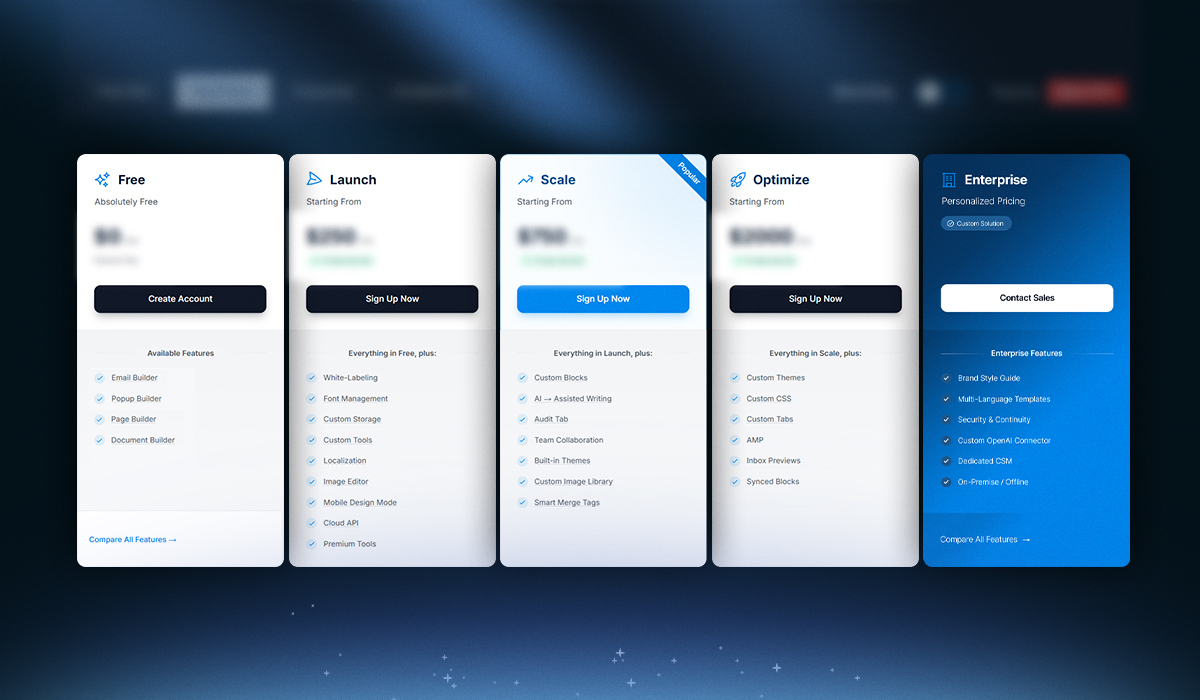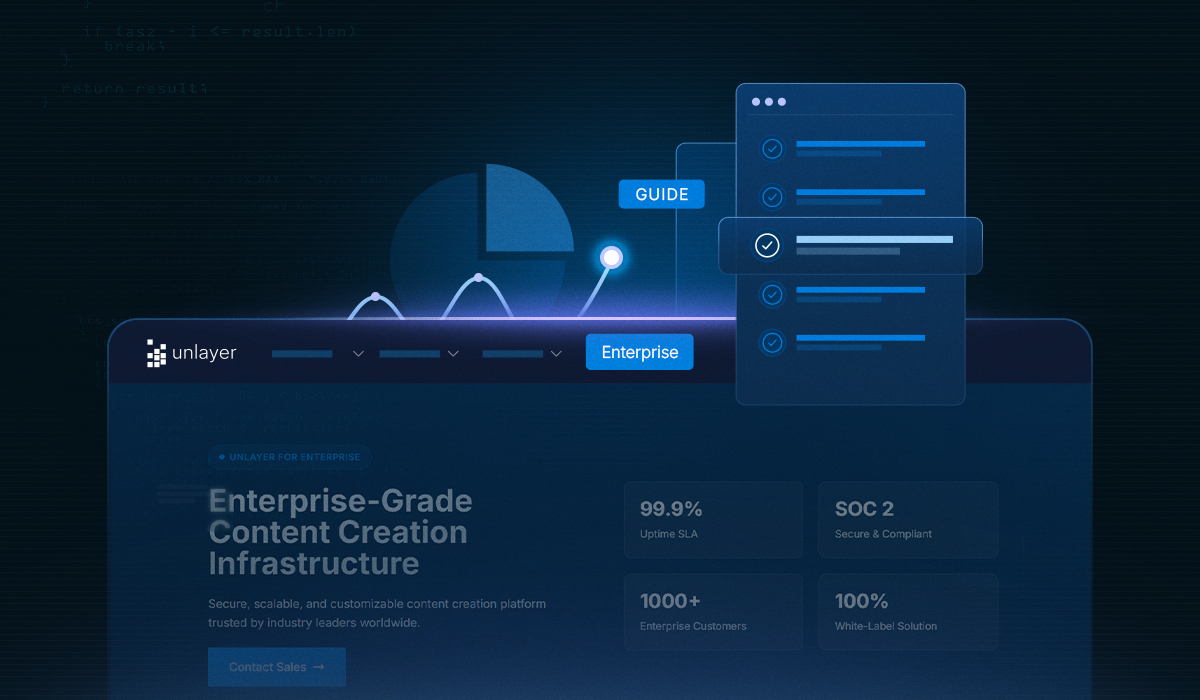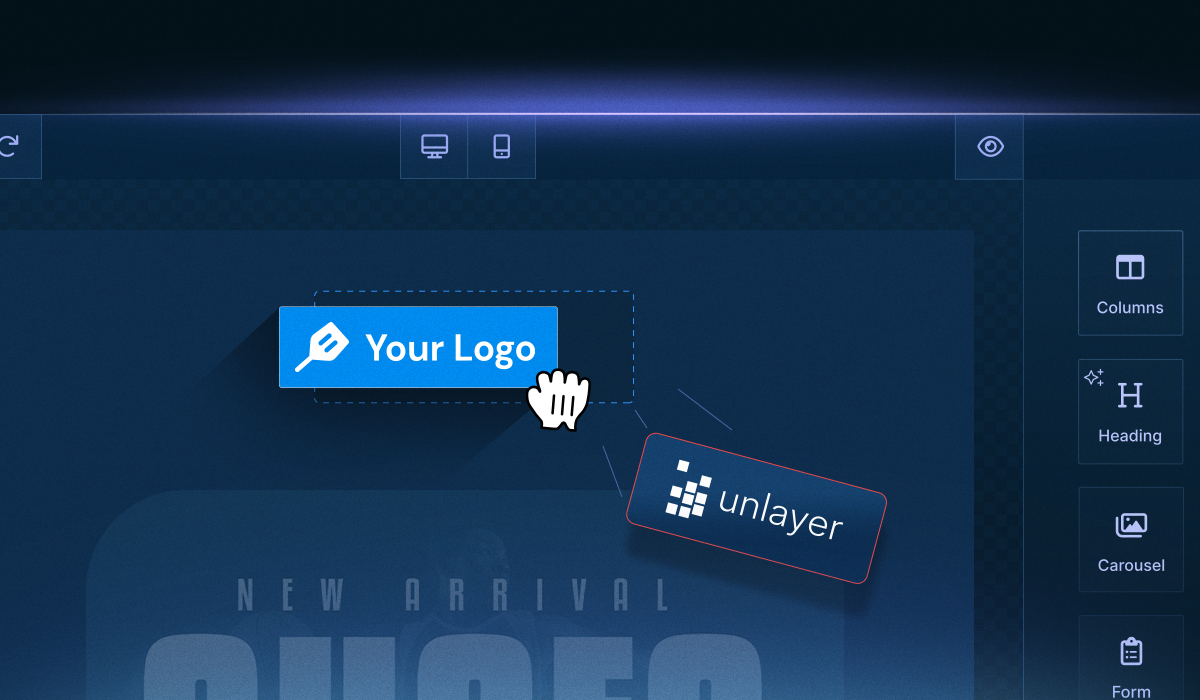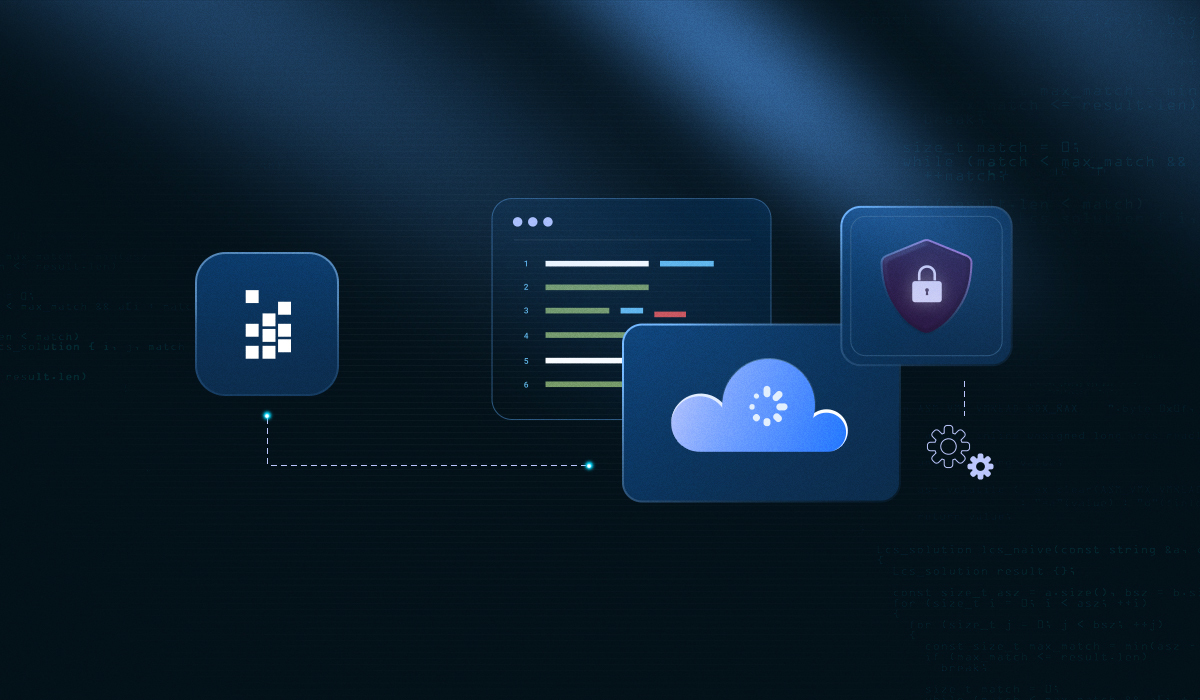Unlayer is a powerful embeddable editor that helps businesses design beautiful emails, landing pages, popups, and more; all without needing advanced coding skills.
Whether you’re a fast-growing startup or a large enterprise, Unlayer makes it easy to give your users professional design tools directly inside your platform.
But when it comes to getting started, many businesses find themselves asking the same question: Should we go with the Self-Serve plan or invest in the Enterprise solution?
This guide breaks down the key differences between the two so you can decide which option best fits your needs, whether you’re running a lean SaaS startup, scaling into the mid-market, or operating as a large enterprise with strict compliance requirements.
What are the Self-Serve Plans?

Unlayer’s Self-Serve plans, Launch, Scale, and Optimize, are designed for businesses that want to embed email and page builders quickly without the complexity of custom enterprise setups.
These plans include all the essentials: a drag-and-drop editor, pre-built templates, SDKs, APIs, and standard customization options like themes, blocks, and tools.
They’re flexible, pay-as-you-go, and ideal for teams that want speed and scalability without enterprise-grade requirements.
Typical use cases:
Startups testing a new SaaS product.
SMBs needing an affordable, ready-to-use builder.
Companies that want to get to market fast without heavy compliance or deployment needs.
What is the Enterprise Plan?

The Enterprise Plan is Unlayer’s fully customizable solution built for large-scale SaaS platforms and organizations with strict compliance or advanced workflow needs.
It includes everything from the Self-Serve plans (Launch, Scale, Optimize) plus enterprise-grade enhancements.
Key features include:
Security & Compliance: SOC 2, GDPR, uptime SLAs, audit logs, and enterprise continuity.
Customization: White-labeling, brand style guides, custom OpenAI connectors, server-side rendering, multi-language templates, and custom exporters.
Deployment Options: Flexible hosting, including private cloud and on-premise/offline deployments.
Support: Priority response, a dedicated Customer Success Manager, custom SLAs, technical consulting, and migration assistance.
Advanced Workflows: Early access to new features, delayed release controls, and API-first infrastructure.
Who chooses Enterprise?
Typically, it’s selected by large SaaS companies, regulated industries (like healthcare, airline ticketing, or finance), and fast-scaling platforms that require airtight compliance, deep customization, and guaranteed performance.
Unlayer Enterprise vs Self-Serve: Feature-by-Feature Comparison
Here’s how Self-Serve and Enterprise stack up across key categories.
Category | Self-Serve (Launch, Scale, Optimize) | Enterprise |
Security & Compliance | Standard protections; no SLA | Enterprise-grade security, SOC 2 & GDPR compliance, custom agreements, uptime SLA, continuity guarantees |
UI / Brand Control | White-labeling, custom themes, fonts, CSS | Everything in Self-Serve + Brand Style Guide, full branding control |
Customization & Integration | SDKs, APIs, custom tools (up to 5 in Optimize), custom storage, image libraries | Unlimited custom tools, custom exporters, server-side rendering, custom OpenAI connector, advanced integrations |
Content Builders | Email, page, popup, and document builders with templates & design features | All Self-Serve builders + multi-language support, advanced content auditing, delayed releases, early access features |
Deployment Options | Cloud-hosted only | Cloud, private cloud, or on-premise/offline deployment |
Collaboration & Access | User roles & permissions, team collaboration (varies by plan) | Enterprise-grade collaboration, unlimited users, enhanced access control, SSO |
Support & Services | Standard support (docs, tickets, community) | Priority support, dedicated CSM, custom SLAs, migration & training services |
Analytics & Reporting | Basic audit tab & usage tracking | Advanced analytics, detailed audit logs, custom audit validators, API-first infrastructure |
👉 For the full feature breakdown and pricing, view this page.
Unlayer Enterprise vs Self-Serve: Pros & Cons of Choosing Each
Now, let’s weigh the pros and cons of both options to see which plan delivers the most value for your business.
Self-Serve plans
Pros:
Quick setup and easy onboarding
Lower cost with flexible plans
Great for startups and SMBs testing or scaling
Cons:
Cost per user rises as teams grow
Less tailored for complex enterprise workflows
Enterprise plan
Pros:
Enterprise-grade security, compliance, and uptime guarantees
Fully customizable (branding, deployment, integrations)
Dedicated support with CSM, SLAs, and training
Per-user costs drop as you scale
No imposed usage limits
Cons:
Higher investment compared to Self-Serve
Longer onboarding and implementation cycle
Cost & Value: Pricing Differences & What Drives Cost Up
Plan | Price (USD/month) | What You Get at That Tier | What Adds to Cost |
Free | $0 | Basic builders (email, page, popup, document), core design tools. | Limited customization, no white-labelling, limited collaboration, or premium features. |
Launch | ~$250/month | Everything in Free, plus white-labeling, font management, custom storage, custom tools, localization, image editor, mobile design mode, Cloud API, and premium tools. | Cost increases when you need custom tools, storage, and more branding control. |
Scale | ~$750/month | Everything in Launch, plus team collaboration, audit tab, custom blocks, smart merge tags, built-in themes, and custom image library. | More users/collaborators, specialized tools, higher limits, richer feature use push costs upward. |
Optimize | ~$2,000/month | All Scale features + custom themes, CSS, tabs, AMP, inbox previews, synced blocks. | Deep branding/customization, more sophisticated features like AMP/inbox previews, richer content workflows raise cost. |
Enterprise | Custom / Contact Sales | Includes everything in Optimize plus enterprise-grade features: Brand Style Guide, Custom OpenAI connector, Multi-Language Templates, Custom Exporters, Server-Side Rendering, On-Premise/offline deployment, Priority Support, Dedicated Customer Success Manager, Custom Agreements, Security & Continuity. | Custom deployment, compliance/security requirements, high SLAs, personalized integrations all drive up cost significantly. |
Cost & Value: Pricing, ROI & Decision Guide
Self-Serve plans (Public pricing)
Plan | Monthly Price | Notable Features | Approx. Cost per Feature* | Users |
Launch | ~$250 | ~20–25 advanced features (white-labeling, fonts, API, custom tools x1–3, storage, themes) | ~$10–12 per feature | Designed for small teams (5–15) → ~$17–50 per user |
Scale | ~$750 | ~35–40 features (team collaboration, custom blocks, audit tab, merge tags, custom image library) | ~$19–22 per feature | Mid-sized teams (15–50) → ~$15–50 per user |
Optimize | ~$2,000 | ~50+ features (custom CSS, AMP, synced blocks, inbox previews, advanced personalization) | ~$40 per feature | Larger teams (50–100) → ~$20–40 per user |
*Features counted as “distinct, value-driving capabilities” beyond the Free plan. Cost per feature is illustrative, not literal.
Enterprise (Custom pricing)
Typical range: $3,000–$10,000+/month (based on compliance, deployment model, SLAs, and integrations).
Features: All Optimize features plus enterprise-grade add-ons: Brand Style Guide, SOC 2/GDPR compliance, On-Premise deployment, custom integrations, SLAs, dedicated support.
ROI Factor: Cost-per-feature looks higher ($150–300/feature), but features are compliance-heavy and high-value. Per-user costs drop dramatically at scale.
Example:
$5K/month for 200 users → $25 per user.
At 1,000+ users, the per-user cost becomes negligible compared to Self-Serve.
ROI by scale: Which plan makes sense?
Small Teams (5–20 users) → Self-Serve wins. Lower monthly outlay, flexible setup, no enterprise overhead.
Mid-Sized Teams (50–200 users) → Costs converge. Optimize ($2K) vs. Enterprise ($3–5K). If compliance, SLAs, or advanced white-labeling matter, Enterprise ROI improves.
Large Enterprises (200+ users) → Enterprise almost always wins. Per-user cost drops, and security + support justify the investment.

Conclusion
When weighing Unlayer Enterprise vs Self-Serve, the right choice depends on where your business is today and where it’s headed.
Self-Serve is a smart, low-friction entry point for startups and fast-moving teams.
But if you anticipate strict compliance needs, larger user bases, or the need for advanced customization, investing in Enterprise early can save you costly migrations later.
In short, Self-Serve gets you moving fast, while Enterprise future-proofs your platform.




